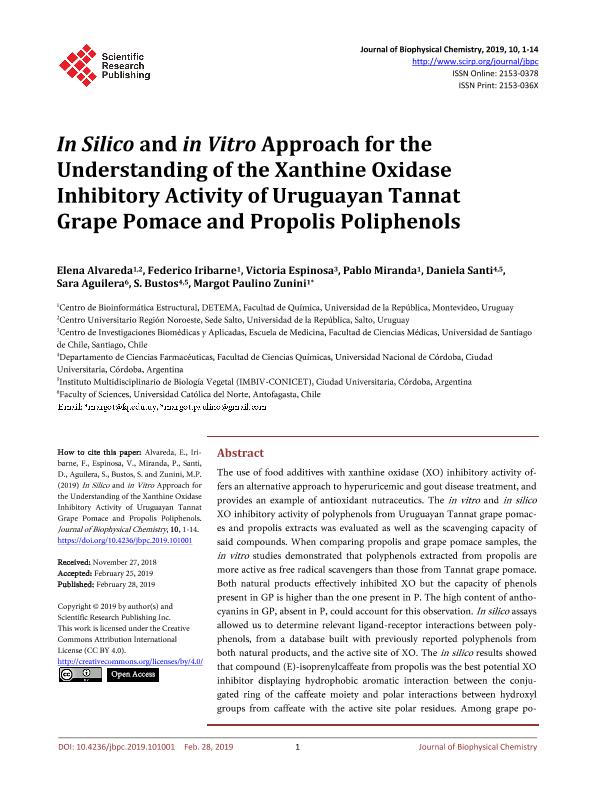Artículo
In Silico and in vitro approach for the understanding of the Xanthine Oxidase Inhibitory Activity of Uruguayan Tannat Grape Pomace and Propolis Poliphenols
Alvareda, Elena; Iribarne, Federico; Espinosa, Victoria; Miranda, Pablo; Santi, María Daniela ; Aguilera, Sara; Bustos, Pamela Soledad
; Aguilera, Sara; Bustos, Pamela Soledad ; Paulino Zunini, Margot
; Paulino Zunini, Margot
 ; Aguilera, Sara; Bustos, Pamela Soledad
; Aguilera, Sara; Bustos, Pamela Soledad ; Paulino Zunini, Margot
; Paulino Zunini, Margot
Fecha de publicación:
02/2019
Editorial:
Scientific Research Publishing
Revista:
Journal of Biophysical Chemistry
ISSN:
2153-0378
e-ISSN:
2153-036X
Idioma:
Inglés
Tipo de recurso:
Artículo publicado
Clasificación temática:
Resumen
The use of food additives with xanthine oxidase (XO) inhibitory activity offersan alternative approach to hyperuricemic and gout disease treatment, andprovides an example of antioxidant nutraceutics. The in vitro and in silicoXO inhibitory activity of polyphenols from Uruguayan Tannat grape pomacesand propolis extracts was evaluated as well as the scavenging capacity ofsaid compounds. When comparing propolis and grape pomace samples, thein vitro studies demonstrated that polyphenols extracted from propolis aremore active as free radical scavengers than those from Tannat grape pomace.Both natural products effectively inhibited XO but the capacity of phenolspresent in GP is higher than the one present in P. The high content of anthocyaninsin GP, absent in P, could account for this observation. In silico assaysallowed us to determine relevant ligand-receptor interactions between polyphenols,from a database built with previously reported polyphenols fromboth natural products, and the active site of XO. The in silico results showedthat compound (E)-isoprenylcaffeate from propolis was the best potential XOinhibitor displaying hydrophobic aromatic interaction between the conjugatedring of the caffeate moiety and polar interactions between hydroxylgroups from caffeate with the active site polar residues. Among grape pomaces, the Cyanidin-3-O-(6-(E)-p-coumaroyl)-glucoside was the best XO inhibitor;its moiety oxychromenyl being relevant to the docking stabilization.All these results lead us to propose Uruguayan propolis and Tannat grapepomace extracts as food additives as well as phytopharmaceuticals to decreasethe uric acid levels in gout disease and to act against oxidative stress.
Archivos asociados
Licencia
Identificadores
Colecciones
Articulos(IMBIV)
Articulos de INST.MULTIDISCIPL.DE BIOLOGIA VEGETAL (P)
Articulos de INST.MULTIDISCIPL.DE BIOLOGIA VEGETAL (P)
Citación
Alvareda, Elena; Iribarne, Federico; Espinosa, Victoria; Miranda, Pablo; Santi, María Daniela; et al.; In Silico and in vitro approach for the understanding of the Xanthine Oxidase Inhibitory Activity of Uruguayan Tannat Grape Pomace and Propolis Poliphenols; Scientific Research Publishing; Journal of Biophysical Chemistry; 10; 01; 2-2019; 1-14
Compartir
Altmétricas



